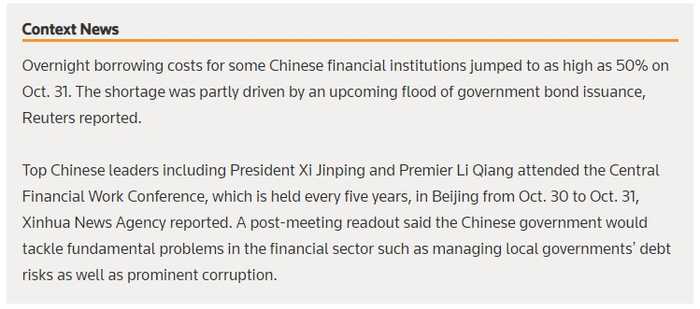Published 18:28 IST, November 2nd 2023
China rate scare reminds watchdogs of hidden risks
China's regulators got a reminder from the money market that both short-term liquidity and long-term reforms are needed for President Xi's financial sector plan
- Opinion
- 2 min read
Overnight fright. China’s top regulators can be in no doubt about the scale of financial risks they have been trying to stamp out. As banking watchdogs this week completed a twice-a-decade summit to set the tone for Chinese President Xi Jinping’s plan to build "a country with a strong financial sector”, China’s money market sent them a reminder that any plan will require short-term liquidity support as well as painful longer-term reforms.
Overnight borrowing rates for some Chinese financial institutions spiked to 50% on Tuesday, according to official interbank data, far in excess of the average rate of roughly 3.6%. The abnormally sharp rise in the cost of pledged repo, a short-term financing tool, was partly due to a seasonal shortage of cash. But it was exacerbated by an upcoming surge of government bond issues, Reuters reported. Traders also pointed to fears of default by cash-strapped institutions such as trust firms and local government financing vehicles that have heavy exposure to China’s ailing real estate sector.
The liquidity squeeze is unlikely to last, especially if the People’s Bank of China injects more cash into the system after Chinese factory activity unexpectedly shrank in October. Yet it's a symptom of deeper financial problems. Chinese public finances have deteriorated at a quicker pace than planners anticipated. That’s why Beijing recently rejigged the central government budget to sell an extra 1 trillion yuan ($137 billion) in sovereign bonds to help local authorities strained by the ongoing crisis in the property market. That probably caught some institutions by surprise, especially those that use short-term borrowing to finance long-term investment – or to speculate on high-yielding property bonds.
In 2012, a national audit confirmed that local governments had amassed up to 10 trillion yuan in debts. Those have since swelled to 92 trillion yuan, per Reuters. After the Central Financial Work Conference concluded on Tuesday, a readout suggested regulators tackle structural issues such as introducing a government debt management system and stronger oversight against corruption. The latest liquidity squeeze is a reminder that short-term dangers will complicate any attempts at more drastic surgery on China’s financial system.

(Source: Reuters Breakingviews)
Updated 18:28 IST, November 2nd 2023